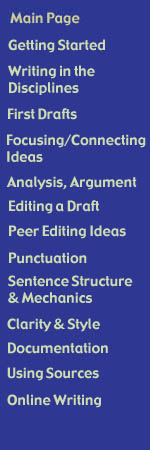

Effective Academic Blogging
by Joe Essid, Writing Center Director
(printable version here)
Blogs provide an excellent forum, when used well, for informal writing and feedback from peers and faculty. Increasing numbers of professionals use blogs to share specialized news and test ideas. On the other hand, blogs can be little more than scattershot musings of a narcissistic mind.
What, then, makes a great blog that provides academic content for an academic audience? Though I blog for both non-academic and academic audiences, I offer this advice based on posts from my blogs that have garnered the most positive comments. Special note to faculty assigning and assessing blogs: consult this excellent post from The Chronicle of Higher Education.
Get To The Point And Stay There. Too often student writers ramble when given an informal topic. Instead, focus. Blog posts need to have the same sense of focus that a formal paper has, yet do so in very few words. That means a blog post must cover, at best, one or two claims and provide evidence for them. The "ProfHacker" bloggers at The Chronicle of Higher Education do this well. You can tell from the title the blog's topic and, in many cases, governing claim. Alternately, a writer might raise a provocative or interesting question in a post and ask readers to opine about it. This is a perfect use of collaborate writing technology.
Wagner James Au, whose blog "New World Notes" covers gaming, virtual worlds, and economics of this industry, published an excellent short post for potential writers. In it, he identifies a "nut graf" that each blogger needs to prepare. This would be a "nutshell paragraph" of a few sentences to convey the post's main point. Read more from Wagner about the nut graf.
Images Are Less Important Than Organization. Consider the funny picture at Ryan Cordell's ProfHacker post, "How to Start Tweeting (and Why You Might Want To)." Cordell uses the graphic to reinforce his idea that Twitter provides more than news about some stranger's lunch. The placement of the image, often at the start of a post, is fine. At the same time, some students tend to not figure out how to move images around in a blog. They cluster them at the start or end, and this robs the visuals of rhetorical power. The images and any other media need to be part of a discussion.
He also uses the graphic to establish a lighthearted mood. At the same time, the text of his post has a great sense of organization. Note how the advice to readers gets divided neatly and falls under subheadings. There are many ways to accomplish this. Editors have asked me to put bullet-lists or section divisions into longer blog posts.
Finally, note how the follow-up images illustrate how-to points without Cordell having to add more words.
Multimedia Cannot Stand Alone. Many bloggers embed clips from YouTube and other sites. In casual blogging, these elements may stand without much commentary. In academic blogging, however, every element needs to be integrated into the blogger's analysis. As with direct quotations, the writer has to introduce the element, then follow it with analysis afterward.
Posts Are Not Articles. Most academic bloggers write fewer than 1000 words per post. I like my students to begin exploring an idea in a post that may grow into a formal piece of writing. This means a less formal but still appropriate tone, a laying out of concepts, perhaps one post at a time as writers do research or think through a problem. Blogs can make excellent logs of research projects, in fact, so faculty can assess student performance and students can review records of what they found, and did not, during the process.
Back to 'Writing Online'
Writer's Web | Writing Center | Make
an Appointment | Library
Copyright Info